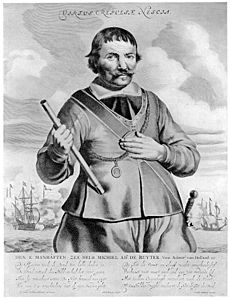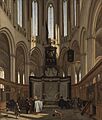Michiel de Ruyter facts for kids
Quick facts for kids
Michiel de Ruyter
|
|
|---|---|
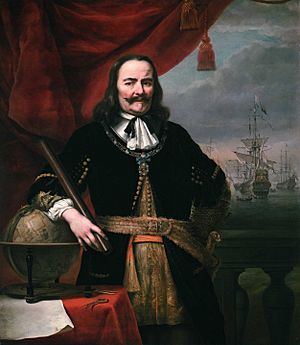
De Ruyter in 1667, by Ferdinand Bol (National Maritime Museum - another autograph version is now in the Rijksmuseum)
|
|
| Birth name | Michiel Adriaenszoon |
| Nickname(s) | Bestevaêr |
| Born | 24 March 1607 Vlissingen, Spanish Netherlands (now Netherlands) |
| Died | 29 April 1676 (aged 69) Syracuse, Spanish Empire (now Italy) |
| Buried |
Nieuwe Kerk, Amsterdam
|
| Allegiance | |
| Branch | Dutch State Navy |
| Service years | 1637–1676 |
| Rank | Lieutenant-admiral general |
| Wars |
|
| Awards | Order of Saint Michael |
| Relations | Engel de Ruyter (son) |
Michiel Adriaenszoon de Ruyter (born March 24, 1607 – died April 29, 1676) was a famous Dutch admiral. Many people consider him one of the most skilled admirals in history. De Ruyter is best known for his amazing achievements with the Dutch Navy during the Anglo-Dutch Wars. He fought against English and French forces and won many important battles. The Raid on the Medway is his most famous victory.
People often call De Ruyter a Dutch folk hero. He was one of the few officers in the Dutch navy to hold the title of lieutenant admiral. His sailors and subordinates loved him. They often called him Bestevaêr, which means "grandfather" in an old Dutch language. This nickname is still sometimes used for him today.
Contents
Early Life and First Adventures
De Ruyter was born in Vlissingen, a city in what is now the Netherlands, on March 24, 1607. His father was a seaman. Michiel started working at sea when he was just 11 years old. This was a common age for boys from his region to begin sailing.
In 1622, when he was 15, he fought as a soldier in the Dutch army. This was during the Eighty Years' War against Spain. He helped defend the city of Bergen-op-Zoom. After this, he went back to working on merchant ships. He slowly moved up the ranks, becoming a ship's captain by age 30. Even though he didn't have much formal schooling, he could speak French and English well.
De Ruyter often traveled to the Mediterranean Sea and the Barbary Coast for trade. During these years, he used his birth name, "Machgyel Adriensoon." The name "De Ruyter" was probably a nickname. Some say it came from an old Dutch word meaning "to raid," because he was known to be a privateer. Others think it means "horseman," honoring one of his grandfathers.
He married Maayke Velders in 1631, but she died shortly after. In 1636, he married Neeltje Engels, and they had four children. In 1637, De Ruyter became captain of a private ship. His job was to hunt down raiders from Dunkirk who attacked Dutch merchant ships.
In 1641, he became a captain in the Dutch navy. He joined a fleet helping the Portuguese fight Spain. He showed great bravery in a battle off Cape St. Vincent. After this, he went back to trading voyages. Between 1642 and 1651, he made a lot of money trading in places like Morocco, Brazil, and the Caribbean. By 1651, he had enough money to retire. His second wife died in 1650. In 1652, he married Anna van Gelder. He bought a house, but his retirement didn't last long.
First Anglo-Dutch War: A New Challenge
The First Anglo-Dutch War started in 1652. De Ruyter agreed to join the growing Dutch fleet as a junior officer. He was called a commandeur, similar to a commodore. He commanded a group of warships from Zeeland. His main job was to protect Dutch merchant ships sailing through the English Channel.
In August 1652, De Ruyter was escorting about 60 Dutch merchant ships. An English fleet, with about 45 ships, spotted them. On August 16, the English tried to attack the Dutch merchant ships. But De Ruyter bravely counter-attacked, protecting the convoy. He surrounded the English warships that had attacked. The battle lasted until nightfall. De Ruyter won this Battle of Plymouth by protecting his convoy from a stronger force. He also fought in the Battle of the Kentish Knock and the Battle of the Gabbard.
The war ended when the Dutch commander, Maarten Tromp, died. De Ruyter was offered the top command, but he refused. He felt others were more qualified. Later, he became good friends with Johan de Witt, an important Dutch leader. De Ruyter became vice-admiral for the city of Amsterdam in 1654. He moved his family there in 1655.
Protecting Trade in the North
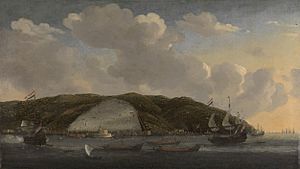
In 1655, De Ruyter commanded a group of eight ships. He sailed to the Mediterranean Sea with 55 merchant ships. His mission was to protect Dutch trade and free Christians who had been enslaved in Algiers. He avoided conflict with an English fleet he met. He captured several famous pirates and made a peace deal with Salé. He returned home in May 1656.
That same month, the Dutch government decided to send a fleet to the Baltic Sea. This was to stop the Swedish king, Charles X, from expanding his power. De Ruyter joined this fleet. They sailed to relieve the city of Danzig, which was under siege. They succeeded without fighting. De Ruyter met the Danish king, Frederick III, and they became friends.
In 1658, the Dutch sent another fleet to the Baltic Sea to help the Danes against Sweden. De Ruyter was blocking Lisbon at the time. Another admiral led the fleet to a Dutch victory in the Battle of the Sound. Still, the Swedes were not defeated. De Ruyter then took command of a new fleet. He managed to free the city of Nyborg in 1659. For this, the Danish King Frederick III made him a knight. From 1661 to 1663, De Ruyter continued to protect Dutch convoys in the Mediterranean.
Second Anglo-Dutch War: Major Victories

In 1664, before the Second Anglo-Dutch War started, English forces captured Dutch trading posts in West Africa. Johan de Witt, the Dutch leader, wanted to respond. He sent De Ruyter's fleet from the Mediterranean to West Africa. De Ruyter quickly recaptured all the Dutch posts. Then, he sailed to the Caribbean to attack English ships.
In April 1665, De Ruyter arrived off Barbados. He led his fleet of thirteen ships into Carlisle Bay. They exchanged fire with English forts and destroyed many ships. But he couldn't silence the English guns and his ships took damage. He went to French Martinique for repairs. After that, he captured some English ships and delivered supplies to a Dutch colony. He decided not to attack New York City because his ships were damaged. He then sailed to Newfoundland, capturing more English merchant ships. He even briefly took the town of St. John's.
The Second Anglo-Dutch War officially began in March 1665. In the first year, the Dutch suffered a terrible defeat at the Battle of Lowestoft. Many ships were lost, and their commander was killed. When De Ruyter returned, he was chosen to lead the Dutch fleet. He became lieutenant-admiral on August 11, 1665.
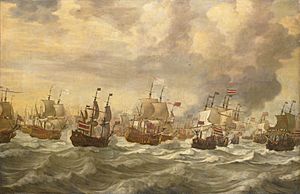
In 1666, De Ruyter won the very tough Four Days' Battle. The English fleet was divided, giving the Dutch an advantage. After two days of fighting, the English retreated. But they got more ships and fought strongly on the fourth day. De Ruyter launched a surprise attack that made the English retreat again.
However, the English fleet was not destroyed. In August, the Dutch suffered heavy losses in the St. James's Day Battle. After this, De Ruyter became very ill. He recovered just in time to lead the famous Raid on the Medway in 1667. This raid was a huge defeat for the English. The Dutch captured the English flagship, HMS Royal Charles. The war ended with the Peace of Breda.
Between 1667 and 1671, De Ruyter was not allowed to sail. This was to keep him safe. In 1669, someone tried to stab him at his home.
Third Anglo-Dutch War and Final Battle
The peace treaty didn't solve all the problems between England and the Netherlands. In 1672, England attacked Dutch ships, and France declared war on the Dutch. This started the Third Anglo-Dutch War. A large combined English and French fleet was formed.
De Ruyter quickly prepared a strong Dutch fleet. He used clever strategies to fight the larger enemy force. He aimed to damage the English ships so they would need long repairs. He also noticed the French fleet didn't want to fight up close. So, he focused his attacks on the English. He also used shallow waters to his advantage, where the larger enemy ships couldn't follow. This way, he stopped the English and French from landing invasion troops.
On June 7, 1672, De Ruyter attacked the combined fleet at the Battle of Solebay. The Dutch focused on the English ships. The French fleet stayed away from the main fight. The battle was not a clear win for either side, but it stopped the English and French plans to invade. This was a big strategic victory for De Ruyter.

The war on land went very badly for the Dutch in 1672. They called it the "disaster year." This led to changes in the government. De Ruyter was sad about the death of his friend Johan de Witt, but he continued to serve. He tried to block the English fleet in the Thames, but they had already sailed. He then gathered his fleet in the shallow waters of the Schooneveld. These waters helped the Dutch, as the larger enemy ships couldn't move easily. In two Battles of the Schooneveld in 1673, he skillfully damaged the enemy fleets. This forced them to stop blocking Dutch ports. Finally, at the Battle of Texel in August, De Ruyter's smaller fleet stopped the larger enemy fleet from landing troops.
In February 1673, a new rank was created especially for De Ruyter: lieutenant-admiral general. The war ended in March 1674 with the Treaty of Westminster.
War Against France and His Death
Even after England left the war, the fighting continued against France. De Ruyter was sent to the Caribbean to fight the French. He arrived off Fort Royal, Martinique, in July 1674. He had 18 warships and many soldiers. However, the French knew he was coming and were ready. When the Dutch soldiers tried to attack, they suffered many losses. De Ruyter decided against more attacks and returned to Europe.
In 1675, the people of Messina in Sicily rebelled against Spanish rule and asked France for help. Spain then asked the Dutch for help. De Ruyter was sent to the Mediterranean with 18 warships. He felt his force was not strong enough.
In January 1676, De Ruyter's fleet met a French fleet near the Lipari Islands. The French fleet was more powerful. During the Battle of Stromboli on January 8, De Ruyter's ships fought bravely. They kept their distance and fired heavily, causing much damage to the French. After hours of fighting, De Ruyter pulled his fleet back. He had successfully defended his smaller fleet against a stronger enemy.
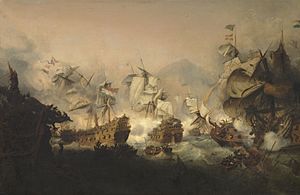
After this battle, a Spanish squadron joined De Ruyter. He gave command of the combined fleet to a Spanish admiral. They decided to attack Augusta to draw out the French fleet. On April 22, 1676, the two fleets met north of Augusta. De Ruyter commanded the front part of the fleet. The battle was a fierce fight.
During this battle, De Ruyter was badly wounded when a cannonball hit his leg. He died a week later in Syracuse. It is said that his French enemies honored him by firing salutes as the ship carrying his body sailed past their fleet. On March 18, 1677, De Ruyter was given a grand state funeral. His body was buried in the Nieuwe Kerk in Amsterdam. His beautiful tomb, finished in 1681, is still there.
Legacy
De Ruyter was greatly respected by his sailors and soldiers. They called him bestevaêr ("grandfather") because he was humble and brave. He was not afraid of risky missions.

There is a statue of him in his hometown, Vlissingen, looking out over the sea. Many towns in the Netherlands have streets named after him. People outside the Netherlands also respected him. The town of Debrecen in Hungary even built a statue of him. This was because he helped free 26 Protestant Hungarian ministers from slavery in Spanish galleys.
Six ships of the Royal Netherlands Navy have been named after him. Seven ships are named after his flagship, HNLMS De Zeven Provinciën. De Ruyter also helped create the Netherlands Marine Corps in 1665.
In 1954, the Netherlands released two postage stamps to honor Admiral de Ruyter. A movie about his life, called Michiel de Ruyter, was released in 2015.
The town of DeRuyter, New York, in the United States, is also named after the admiral.
Images for kids
-
De Ruyter and De Witt's embarkment at Texel in 1667, by Eugène Isabey
-
The Viceroy of Naples pays tribute to De Ruyter's fleet in Naples after the Battle of Stromboli by Jan van Essen
-
praal tomb in the Nieuwe Kerk in Amsterdam, made by Rombout Verhulst and painted by Emanuel de Witte
See also
 In Spanish: Michiel de Ruyter para niños
In Spanish: Michiel de Ruyter para niños


